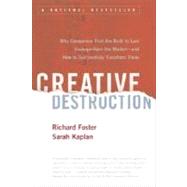
Note: Supplemental materials are not guaranteed with Rental or Used book purchases.
Purchase Benefits
What is included with this book?
| Introduction: The Game of Creative Destruction | 1 | (7) | |||
|
7 | (18) | |||
|
25 | (36) | |||
|
61 | (29) | |||
|
90 | (35) | |||
|
125 | (18) | |||
|
143 | (18) | |||
|
161 | (20) | |||
|
181 | (28) | |||
|
209 | (27) | |||
|
236 | (25) | |||
|
261 | (27) | |||
|
288 | (9) | |||
| Appendix A: List of Companies | 297 | (14) | |||
| Appendix B: Managerial Approach of Principal Investors | 311 | (1) | |||
| Appendix C: Dynamic Performance Analysis (DPA) | 312 | (27) | |||
| Notes | 339 | (11) | |||
| Selected Sources | 350 | (3) | |||
| Index | 353 |
The New copy of this book will include any supplemental materials advertised. Please check the title of the book to determine if it should include any access cards, study guides, lab manuals, CDs, etc.
The Used, Rental and eBook copies of this book are not guaranteed to include any supplemental materials. Typically, only the book itself is included. This is true even if the title states it includes any access cards, study guides, lab manuals, CDs, etc.
Excerpted from Creative Destruction: Why Companies That Are Built to Last Underperform the Market - And How to Successfully Transform Them by Richard Foster, Sarah R. Kaplan
All rights reserved by the original copyright owners. Excerpts are provided for display purposes only and may not be reproduced, reprinted or distributed without the written permission of the publisher.